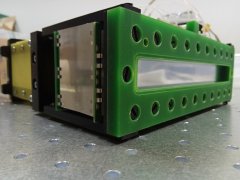The Laboratory focuses on the theoretical and numerical analysis of plasma transport and its impurities in magnetic traps such as tokamak, stellerator and plasma focus.
The Laboratory's research deals with the main challenges of modern plasma devices and future fusion reactors such as plasma confinement and the problem of high heat fluxes falling on structural surfaces, in particular on the surface of the divertor used to remove impurities from the tokamak chamber.
For this purpose, the Laboratory staff has developed numerical codes modelling the transport of multicomponent plasma containing numerical methods dedicated to magnetically confined plasma.
In the boundary area, simulations of the transport of plasma and its admixtures are performed with the application of the multi-fluid TECXY code which is used to evaluate the impact of radiation of various admixtures in the boundary area on the energy fluxes falling on the divertor plates in modern tokamaks: JET (Joint European Torus), TCV (French: Tokamak à configuration variable), WEST (Tungsten Environment in Steady-state Tokamak) or in the designed ITER (International Thermonuclear Experimental Reactor), DEMO (DEMOnstration Power Station), DTT (Divertor Tokamak) reactors Test facility), and CFETR (China Fusion Engineering Test Reactor).
The Laboratory also develops a world-unique, integrated COREDIV code, designed to simulate the transport of admixtures both inside the plasma cord and in the plasma boundary layer for tokamak devices. It is used to analyse the transport of impurities throughout the plasma volume, in particular the influence of tungsten and liquid-metal divertor ions on plasma confinement.
Research carried out in the Wendelstein 7-X stellarator is supported by the multi-fluid FINDIF code which takes into account plasma transport in the complex three-dimensional geometry of the magnetic field.
Numerical research, which has been performed for many years in the IPPLM, significantly contributed to the knowledge of the transport of admixtures in plasma and made it possible to explain many phenomena which occur there.
The significant achievement of the research carried out in the Institute with the application of the COREDIV code was the detection of tungsten accumulation in the plasma cord in the JET device.
Laboratory staff participate in international research within the EUROfusion consortium related to the operation of current fusion devices, cooperating, among others, with teams from Cadarache Research Center (CEA), Culham Center for Fusion Energy (CCFE), Swiss Plasma Center EPFL, Max Planck Institute for Plasma Physics, ITER Organization, Center for Energy, Environment and Technology Research (CIEMAT), Institute of Plasma Physics of the Czech Academy of Sciences, Hefei Institutes of Physical Science of CAS.










